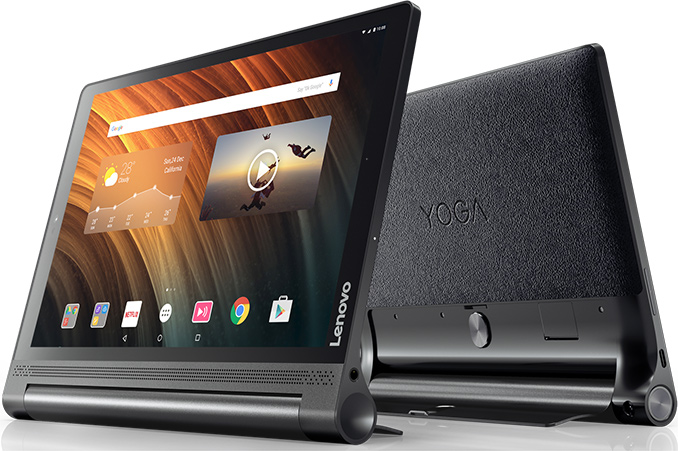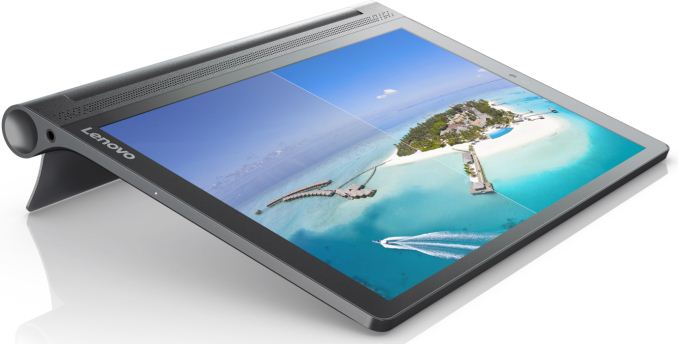Lenovo Yoga Tab 3 Plus: Snapdragon 652, 10-Inch 2K Display, JBL Speakers and USB-C
by Anton Shilov on August 31, 2016 2:35 PM EST
Lenovo has introduced a new member to its Yoga Tab 3 product family this week at IFA. The new Yoga Tab 3 Plus tablet runs Google Android 6.0 and is aimed at demanding consumers. The novelty comes with a number of features previously only available on the Yoga Tab 3 Pro, including a higher-end octa-core SoC, a 2K 10” display, a lot of RAM, plenty of storage as well as Wi-Fi 802.11 ac connectivity. Surprisingly, the Yoga Tab 3 Plus will not be too expensive and will be available starting from $299.
When Lenovo introduced its Yoga Tab 3 family of products last year, the company drew a clear line between its mainstream Yoga Tab and considerably more advanced Yoga Tab 3 Pro tablets. The former were based on entry-level SoCs and were equipped with relatively low-res screens and limited amount of DRAM/NAND, whereas the latter were powered by Intel’s Atom SoC, were equipped with 2560×1600 displays and featured considerably better specs in general, but at a much higher price ($499/$599 for Wi-Fi/Wi-Fi+LTE model). Today, the Yoga Tab 3 closes the gap between the two product lines and attempts to wed the best of both: affordable price and high-end specs.
The Yoga Tab 3 Plus is based on the Qualcomm Snapdragon 652 SoC (4×A72 1.8 GHz, 4×A53 1.4 GHz, Qualcomm Adreno 510 graphics) and comes equipped with 3 GB of LPDDR3 DRAM as well as 32 GB of NAND flash storage (it also has a microSD card slot). The tablet uses USB Type-C (operates in USB 2.0 mode) connector for charging and connectivity and also supports WiFi 802.11 a/b/g/n/ac, Bluetooth 4.0 and LTE (optional) wireless technologies.
| Lenovo Yoga Tab 3 Family | ||||
| Model | Yoga Tab 3 8" | Yoga Tab 3 10" | Yoga Tab 3 Pro 10" | Yoga Tab 3 Plus 10" |
| SoC | Snapdragon 212 4×Cortex-A7 at 1.3GHz Adreno 304 graphics |
Intel Atom x5-Z8500 Quad core, 2.24GHz |
Snapdragon 652 4×Cortex-A72 at 1.8GHz 4×Cortex-A53 at 1.4 GHz Adreno 510 graphics |
|
| RAM, NAND | 1GB, 16GB NAND + MicroSD | 2GB RAM, 16/32GB NAND + MicroSD |
3GB RAM, 32GB NAND + MicroSD |
|
| Display | 8" 1280x800 IPS LCD | 10.1" 1280x800 IPS LCD | 10.1" 2560x1600 IPS LCD 299 ppi, 70% Color Gamut |
|
| Dimensions | 210 x 146 x 3 to 7mm | 253 x 185 x 3.5 to 9.5mm 655g |
179 x 247 x 4.6mm at thinnest point, 665g | 179 x 247 x 4.68mm at thinnest point, 637-644g |
| Camera | 8MP Rotatable Camera | 13MP Rear-facing 5MP Front-facing |
||
| Battery | 6200mAh (23.56Wh) | 8700mAh (33.06Wh) | 10200mAh (38.76Wh) | 9300mAh |
| OS | Android 5.1 Lollipop | Android 5.0 Lollipop | Android 5.1 Lollipop | Android 6.0 |
| Connectivity | 802.11b/g/n + BT 4.0, microUSB 2.0, Optional LTE SKU | 2x2 802.11a/b/g/n/ac + BT 4.0, microUSB 2.0, Optional LTE |
2x2 802.11a/b/g/n/ac + BT 4.0, USB-C, Optional LTE |
|
Lenovo positions its Yoga Tab 3 Plus tablet for those, who want to have enhanced multimedia experience on-the-go, which is why its 10-point multitouch 10.1” WQXGA (2560×1600) IPS display comes with Technicolor’s color enhance software technology. In addition, the device is equipped with four front-facing speakers (made by JBL) and supports Dolby's Atmos 3D surround sound processing. Now, unlike the Yoga Tab 3 Pro, the Tab 3 Plus does not feature a pico projector, but just like the aforementioned model, it has two cameras.
Battery capacity of the novelty is 9300 mAh and Lenovo claims that the Yoga Tab 3 Plus will last up to 18 hours on its battery. As it turns out, slightly lower battery capacity of the Yoga Tab 3 Plus compared to the Yoga Tab 3 Pro is offset by better energy efficiency of its SoC, which is why it promises to deliver similar battery life. Besides long battery life, the Yoga Tab 3 Plus also inherited premium chassis featuring metal, plastic and leather from the Pro model.
Lenovo will start shipments of its Yoga Tab 3 Plus this October. The MSRP for the Wi-Fi-only model will be $299, but the recommended price of the LTE SKU is currently unknown.
Source: Lenovo

















33 Comments
View All Comments
Spectrophobic - Thursday, September 1, 2016 - link
A bit offended you guys called 2560x1600 "2K".marcolorenzo - Friday, September 2, 2016 - link
Can someone explain to me why no Android tablet maker seem to want to release a tablet with a top of the line SoC? I get it if they just want to compete in the low-mid range market but how come there's not a single Android OEM willing to use a high end SoC for the last few years? Samsung is even crazy enough to release tablets with year old SoCs and still charge prices that are up there with the iPads. I really don't get it.UtilityMax - Saturday, September 17, 2016 - link
That's a really good question, and I don't know the answer.I am guessing the problem is the usual fact that "tablet sales are poor". This doesn't explain though how come even flagship android tablets have SoC that gets poorer Geekbench scores than iPad Mini 2 from 2013.